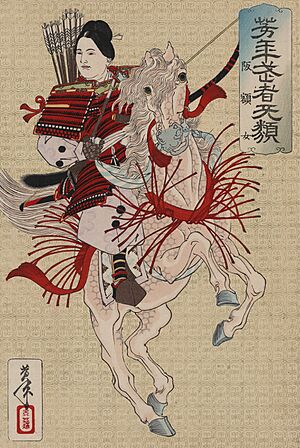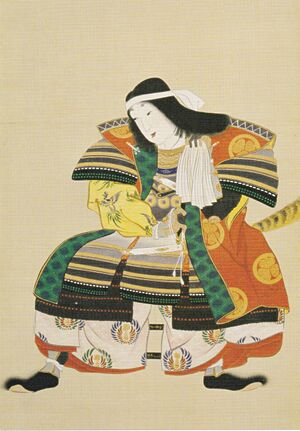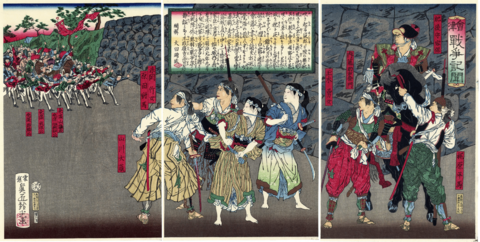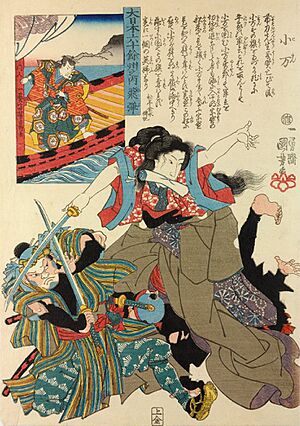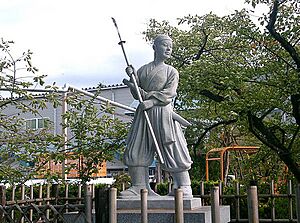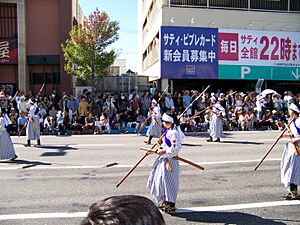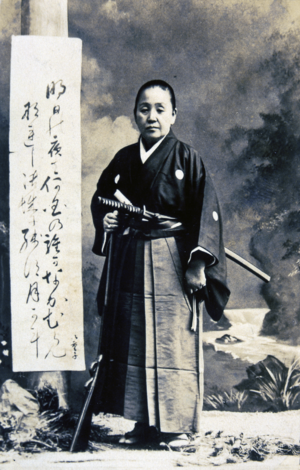Onna-musha facts for kids
Onna-musha (女武者) is a term for female warriors in old Japan. These women were part of the bushi (warrior) class. They learned how to use weapons to protect their homes, families, and honor during wartime. Many onna-musha even fought in battles alongside male samurai.
Some Onna-musha are also famous in Japanese literature and stories. Tomoe Gozen and Hangaku Gozen are two well-known examples.
Contents
Female Warriors in Early Japan
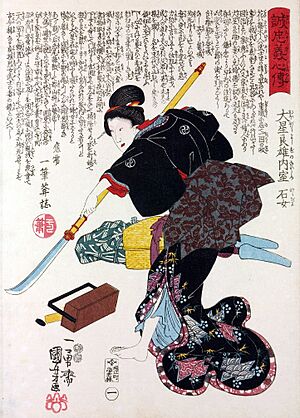
The Kamakura Period (1185–1333)
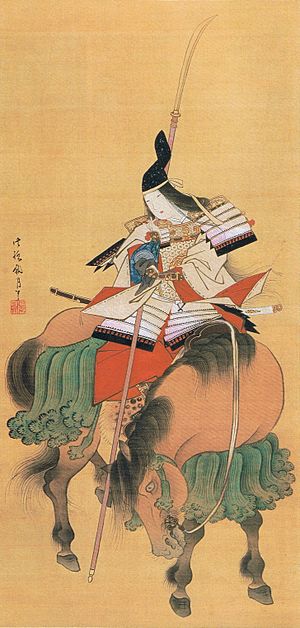
The Genpei War (1180–1185) was a big fight between two powerful Japanese families, the Taira and Minamoto clans. These clans were very important in the late Heian period. A famous story called The Tale of the Heike was written to remember the brave samurai from this war.
One of these brave warriors was Tomoe Gozen. She served Minamoto no Yoshinaka of the Minamoto clan. Tomoe helped Yoshinaka defend himself against his cousin's army, especially during the Battle of Awazu in 1184.
The Tale of the Heike described her as:
...very beautiful, with fair skin and long hair. She was also a strong archer and a skilled swordswoman, worth a thousand warriors. She could face a demon or a god, whether on horseback or on foot. She rode wild horses with great skill and rode safely down dangerous hills. Before a battle, Yoshinaka would send her out as his first captain. She wore strong armor, carried a large sword, and a powerful bow. She performed more brave acts than any of his other warriors.
For a long time, some people wondered if Tomoe Gozen was a real person. However, her story has greatly influenced the warrior class, including many traditional schools that teach how to use the naginata. Her actions in battle are often shown in art, like in the Noh play Tomoe and in many ukiyo-e (Japanese woodblock prints).
Another famous female general from the Genpei War was Hangaku Gozen. While Tomoe Gozen fought with the Minamoto clan, Hangaku joined the Taira clan. The fact that these two important female generals existed shows that women had more equal standing during this time than in later periods.
In the past, it was more common for women to become empresses. However, this changed later, especially during the Meiji Restoration. Throughout Japanese history, even if women did not officially lead samurai clans, they often unofficially controlled them in many cases.
A writer named Tōin Kinkata (1291–1360) wrote in his journal about a "mostly female cavalry." He didn't explain much more, just that "there is a lot of female cavalries." He noted they were from western Japan. This suggests that women in areas far from the big cities might have been more likely to fight. Reports of women forming cavalry units also appeared during the Sengoku period (around 1467–1600).
The Sengoku Period (1467–1600)
During the Ashikaga shogunate, Japan faced more wars because of disagreements among the shogun's supporters. In 1460, when Shogun Ashikaga Yoshimasa stepped down for his younger brother, Ashikaga Yoshimi, Yoshimasa's wife, Hino Tomiko, strongly disagreed. Tomiko gathered political and military support to rule as a regent until her son was born. She got help from Yamana Sōzen and other powerful samurai leaders.
Then, she went to war against Yoshimasa and his supporters, especially the Hosokawa clan. This fight over who would rule started the Ōnin War (1467–1477). This war also marked the beginning of the Sengoku period, a time of constant conflict.
During the Azuchi–Momoyama period, many daimyō (powerful lords) took control of their own areas and fought each other. Women from noble families and even peasant women, who were part of groups like Ikkō-ikki, joined these battles. In 1569, when a Mori family warrior was away, his wife, Ichikawa no Tsubone, took charge of defending Kōnomine Castle. She did this with her armed ladies-in-waiting.
Attacks on yamashiro (山城; mountaintop castles) often forced women to defend their homes. If a castle fell, they sometimes had to make the ultimate sacrifice.
Women continued to fight in battles until Toyotomi Hideyoshi united Japan. In 1591, several women defended Kunohe Castle even when it was on fire during the Kunohe Rebellion. After Hideyoshi died, his concubine, Yodo-dono, became the unofficial leader of the Toyotomi clan. In 1614, she and her son, Hideyori, fought against the rising Tokugawa shogunate. In 1615, when Tokugawa Ieyasu attacked Osaka Castle again, Yodo-dono and her son died in the castle's flames.
Proof of Women in Battles
During the Sengoku period, many stories tell of women actively fighting. For example, Myōrin inspired people to fight against 3,000 Shimazu soldiers. Kaihime fought against the Toyotomi clan in the siege of Oshi (1590). Onamihime became the leader of the Nikaidō clan and fought against her nephew, Date Masamune. Akai Teruko was famous for fighting until she was 76 years old. She was known as "The Strongest Woman in the Warring States Period." The actions of Ōhōri Tsuruhime earned her the title "Joan of Arc of Japan." This made her one of the most recognized female warriors in Japanese history.
In the 16th century, there were even combat units made only of women. Ikeda Sen led 200 women musketeers (a gun unit) in the Battle of Shizugatake and Battle of Komaki-Nagakute. Otazu no kata fought with 18 armed maids against Tokugawa Ieyasu's troops. Ueno Tsuruhime led thirty-four women against the Mōri army. Tachibana Ginchiyo, the leader of the Tachibana clan, fought with her female troops in the Kyūshū Campaign (1586). In the siege of Yanagawa (1600), she organized a group of nuns to resist the advancing Eastern Army.
In 1580, a woman from the Bessho clan joined a rebellion against Toyotomi Hideyoshi during the siege of Miki. Her husband, Bessho Yoshichika, was a leader of the rebellion. She played a key role during the siege, working with the Mori clan. The rebellion lasted three years. Finally, Bessho Nagaharu surrendered the castle to Hideyoshi. Lady Bessho took her own life soon after.
In 1582, Oda Nobunaga launched a final attack on the Takeda clan. This was a series of battles known as the Battle of Tenmokuzan. Oda Nobutada (Nobunaga's son) led 50,000 soldiers against 3,000 Takeda allies during the siege of Takato castle. During this battle, records from the Oda clan (called Shinchō kōki) state that a woman from the Suwa clan fought against Nobutada's forces.
Many more women likely fought in battles than what historical records show. For example, some studies suggest that many women were present on battlefields. Archeologist Suzuki Hiroatsu found that in areas where battles happened away from castles, about 30% of the bodies found were women. This suggests these women came to fight and die, not just defend a castle.
The Edo Period (1603–1868) and Beyond
During the Edo neo-Confucianism period (1600–1868), the role of the onna-musha changed a lot. Samurai were no longer mainly fighting. Instead, they became bureaucrats (government workers). Women, especially daughters from wealthy families, were often used to gain success and power through marriage. The old ideas of fearless devotion and bravery slowly changed to quiet, obedient behavior.
Traveling during the Edo period was difficult for many female samurai because of strict rules. They always had to be with a man, as they could not travel alone. They also needed special permits that explained their reasons for travel.
By the 17th century, society's view of women in Japan had changed significantly. Many samurai saw women only as mothers. The idea of a woman being a good companion for war was no longer accepted. The relationship between a husband and wife became similar to that of a lord and his servant.
Even though women mostly learned how to use the naginata, some broke tradition and learned other fighting styles, like Kenjutsu (sword fighting). Sasaki Rui, Chiba Sanako, and Nakazawa Koto are examples of women who became famous swordswomen during the Edo period. During this time, schools led by women that taught kenjutsu became common.
In 1868, during the Battle of Aizu in the Boshin War, Nakano Takeko was a member of the Aizu clan. She was chosen to lead a female fighting group called the Jōshitai (娘子隊, Girls' Army). This group fought against 20,000 soldiers of the Imperial Japanese Army. Takeko was very skilled with the naginata. She and her group of about 20 women joined 3000 other Aizu samurai in battle. There is a monument in her honor at the Hōkai-ji temple in Aizubange, Fukushima.
Other less famous but equally remarkable women were Yamamoto Yaeko, Matsudaira Teru, and Yamakawa Futaba. They helped defend Aizuwakamatsu Castle during the Battle of Aizu. Yaeko later became one of the first leaders for women's rights in Japan.

The end of the Edo period was a time of great political trouble. This continued into the Meiji period (1868–1912). In 1877, samurai from the Satsuma region led a revolt against the new Meiji government. This was called the Satsuma Rebellion. For almost 1,000 years, women of the samurai class had often been the last line of defense during a military attack. The last records of samurai women fighting in battles were during the Satsuma Rebellion. Several women were said to have fought to defend the city of Kagoshima. This rebellion also effectively ended the samurai class. The new Imperial Japanese Army, made up of regular people, proved itself in battle. This marked the end of the onna-musha history.
Weapons Used by Onna-musha
The most popular weapon for onna-musha was the naginata. This is a long, traditional polearm with a curved blade at the end. Women liked this weapon because its length could make up for the strength and size advantage of male opponents.
The naginata is useful in close combat, keeping opponents at a distance. It is also quite effective against cavalry (soldiers on horseback). Because many legendary samurai women used it, the naginata became the symbol of the female warrior. During the Edo period, many schools focused on teaching how to use the naginata. This helped connect the weapon with women.
Also, since their main job as onna-musha was often to protect their homes from attackers, they also focused on using ranged weapons from defensive buildings.
Legacy of the Onna-musha
The image of samurai women is still important in martial arts, historical novels, books, and popular culture. Like kunoichi (female ninja) and geisha, the behavior of the onna-musha is often seen as the ideal for Japanese women in movies, cartoons, and TV shows. In the West, the onna-musha became more known when the documentary Samurai Warrior Queens was shown on the Smithsonian Channel.
The 56th NHK taiga drama (a historical TV series), Naotora: The Lady Warlord, was the first NHK drama where the main female character was the head of a samurai clan. The 52nd NHK taiga drama, Yae no Sakura, is about Niijima Yae, a woman warrior who fought in the Boshin War. This drama also shows Nakano Takeko, Matsudaira Teru, and other onna-musha. Another taiga drama that shows the famous onna-musha Tomoe Gozen is Yoshitsune, which aired in 2005.
In Japan, Tomoe Gozen and Nakano Takeko influenced naginata schools and their fighting techniques. These schools, whether for men or women, usually honor the onna-musha. During the yearly Aizu Autumn Festival, a group of young girls wearing traditional clothes and headbands join a parade. They do this to remember the actions of Nakano and the Jōshitai (Girls' Army).
Other important examples are Yamakawa Futaba and Niijima Yae. They became symbols of the fight for women's rights in Japan. Some onna-musha have become symbols of a city or region. Ii Naotora and Tachibana Ginchiyo are often celebrated at the Hamamatsu and Yanagawa festivals. The warrior nun Myōrin is celebrated in the Tsurusaki area of Ōita city. Ōhōri Tsuruhime is a main character in local stories and festivals on Ōmishima island. Many other samurai-class women are celebrated in pop culture, business, and local stories.
Famous Onna-musha
Here are some famous onna-musha who achieved amazing things in history:
- Empress Jingū (169–269): A legendary Empress who was part of many important events in Japanese history. She led a mythical invasion of the Korean Peninsula.
- Nakano Takeko (1847–1868): She led the Jōshitai (Girls' Army). She fought in the Boshin War, leading several women in a charge against the Imperial forces. Because of changes in the Meiji era, Takeko and the women of Jōshitai were some of the last samurai in history.
- Niijima Yae (1845–1932): She was one of the last samurai in history. She fought in the Boshin War and worked as a nurse in the Russo-Japanese War and the Sino-Japanese War. Later, she became a scholar and a symbol of the fight for women's rights. Yae was one of the first people to receive an award from the Emperor Meiji.
- Tomoe Gozen (12th century): Her story in the Tale of the Heike inspired many generations of samurai.
- Yodo-dono (1569–1615): A noblewoman who was the leader of Yodo castle. Later, she became the unofficial head of Osaka Castle. She led many political events after her husband, Hideyoshi, died. As the guardian of Hideyori (Hideyoshi's son), she challenged the Tokugawa clan. This led to the Siege of Osaka, the last battle of the Sengoku period. This battle ended the period of war for the next 250 years.
Images for kids
See also
- Empress of Japan
- Female castle leaders in Japan
- Himiko
- Kunoichi (Female Ninja)
- Toyo (queen)
- Woman warrior


